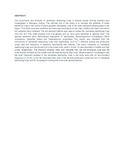Occurrence and diversity of nematode destroying fungi in banana production zones in Maragua, Kenya

Date
2013Author
Wachira, PM
Kimenju, JW
Kiarie, JW
Kihurani, AW
Mwaniki, SW
Type
ArticleLanguage
enMetadata
Show full item recordAbstract
The occurrence and diversity of nematode destroying fungi in banana based farming systems was investigated in Maragua, Kenya. The ultimate aim of the study is to harness the potential of these beneficial fungi in the control of plant parasitic nematodes, one of the most important banana pests in the region. The study area was stratified into three agro-ecological zones; high, middle and lower from which soil samples were collected. The soil sprinkle method was used to isolate the nematode destroying fungi from the soil. Fifty eight isolates from five genera and six taxa were identified to species level. The species identified were; Arthrobotrys oligospora, A. dactyloides, Monacrosporium cionopagum, Meria coniospora, Dactyllela lobata and Harposporium aungullilae. The results also indicated that, the occurrence of nematode destroying fungi was significantly (2.2×10-16) different among the production zones with the frequency of detection decreasing with altitude. The mean frequency of nematode destroying fungi occurrence was 2.8 in the lower zone, while 1.8 and 1.2 was recorded in middle and high zones, respectively. The Shannon diversity index also indicated that, the low ecological zone was the most diverse followed by the middle and the least being the high zone. Monacrosporiun cionopagum was the most frequently isolated of the nematode destroying fungi in the study area with an accumulative frequency of 37.9%. It can be concluded that, soils in the banana production zones are rich in nematode destroying fungi and M. cionopagum is being the most wide spread species.
Citation
Journal of Agricultural Science (Toronto) 2013 Vol. 5 No. 12 pp. 180-186Publisher
University of Nairobi.
